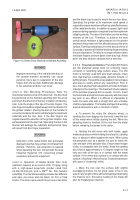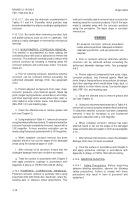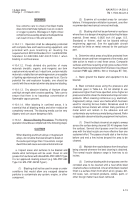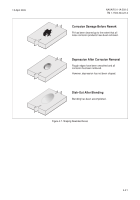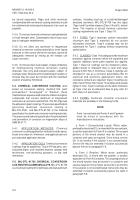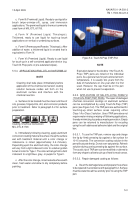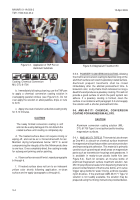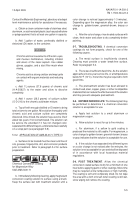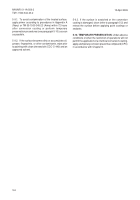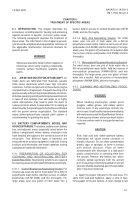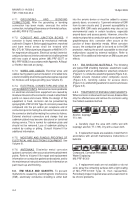TM-1-1500-344-23-2 - Page 99 of 240
5-1
NAVAIR 01-1A-509-2
TM 1-1500-344-23-2
15 April 2009
CHAPTER 5
SURFACE TREATMENT
5-1. PURPOSE
. A critical step in the corrosion
prevention and control process is treating the surface of
the metal with a prescribed chemical to form a protective
oxide film. Properly applied chemical treatment imparts
considerable corrosion resistance to the metal, and
greatly improves the adhesion of subsequently applied
paints or other coatings. Epoxy primers, for example,
which do not adhere well to bare aluminum, adhere very
well to chemical conversion coatings.
5-2. SURFACE PREPARATION
. After completing
corrosion removal in accordance with Chapter 4, proceed
as follows:
a. Feathering Edges of Paint. Feathering of paint
along the edge of areas that have been chemically or
mechanically stripped is required prior to pre-treatment
and repainting to ensure a smooth, overlapping transition
between the old and new paint surfaces. A smooth,
overlapping paint film will ensure the absence of a
rough, soil accumulating junction between the old and
new paint films. Feathering shall be accomplished using
240 or 320 grit aluminum oxide abrasive cloths (ANSI
B74.18), fine or medium aluminum oxide abrasive mats
(A-A-58054), or a fine or very fine powered finishing
brush (3M Radial Bristle Disc with 240 or 320 grit
aluminum oxide abrasive).
NOTE
Aircraft that have been waxed, particularly with
silicone based material, may require special
cleaning to obtain a surface free of water breaks.
When silicone wax is suspected, solvent clean
using an approved cleaning solvent.
b. Clean surface with MIL-PRF-85570 Type II aircraft
cleaning compound (dilute 1 part cleaner to 14 parts
water) and an abrasive mat, then rinse with clean water.
For water sensitive areas, use an approved cleaning
solvent.
c. Lightly abrade the bare or clad surface with a fine
or very fine abrasive mat (A-A-58054) to remove the
oxide layer and any residual chemical conversion
coating. This is the most effective means of preparing
the surface so that it will accept a new chemical
conversion coating. Care shall be taken to ensure that
clad surfaces are not compromised during mechanical
cleaning, as this can reduce the overall corrosion
resistance of the alloy.
d. After abrading the surface, rinse the area by
flushing with clean, fresh water. Particular attention
should be given to fasteners and other areas where
residues may become entrapped. At this stage of the
cleaning process, the surface should be water break-
free (see Figure 5-1). A surface showing water breaks
(water beading or incomplete wetting) is indicative of
contamination, which will later interfere with conversion
coating, sealing, plating, and/or painting.
e. If the surface is not free of water breaks, reclean
the area by repeating paragraphs b, c, and d.
5-3. PRECAUTIONS
. Observe the following
precautions when applying chemical conversion coating
solutions on aluminum or magnesium surfaces:
5-3.1. Chemical conversion coating materials are acidic
and require the use of chemical resistant gloves and
chemical or splash proof goggles by personnel during
handling and application. If the material accidentally
contacts the skin or eyes, flush immediately with plenty
of clean, fresh water. Report to dispensary and/or
consult a physician if eyes are affected or skin is burned.
5-3.2. Mixing and application should be done in an
adequately ventilated area. Avoid prolonged breathing
of vapors.
5-3.3. Some chemical conversion coating materials
are strong oxidizers and a fire hazard when in contact
with combustible materials. Therefore, oxidizers must
Figure 5-1. A Water Break-Free Surface
Compared to One with Breaks
Back to Top

